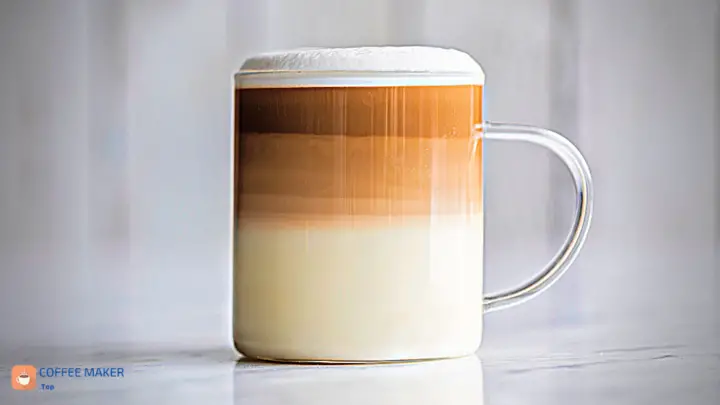Latte Macchiato means stained milk. This name comes from the fact that this drink is mostly milk, where espresso is added to stain it. This way, the espresso will transform the white of the milk into brown and bring a light coffee flavour.
All espresso and milk beverages use the same ingredients; coffee and milk. However, the quantities used and the way these beverages are made make none of them similar to each other.
Latte Macchiato is undoubtedly the most beautiful and elaborate of of coffee&milk drinks, with its three layers served in a tall glass.

What is a Latte Macchiato?
Also known as layered coffee, latte macchiato is often prepared with half a shot of espresso added to the milk. Thus, starting to form a different layer. The final layer of the drink is formed when the foam is added to the top.
The name comes from how it is prepared, where the milk is ‘stained’ with coffee added to create the middle layer. Latte Macchiato is served in a long glass with hot milk added to the bottom, followed by a half shot of espresso and topped with milk foam.
The creamy milk absorbs the delicious flavour of the coffee, resulting in an eye-catching and spectacular coffee. It should be noted that latte macchiato never has more than half a shot of coffee in it, often even less.
Another fundamental difference with a regular Latte, apart from the amount of coffee used (more coffee in a Latte), is how the coffee and milk are added. Latte is traditionally made by adding coffee and pouring milk over it, letting both ingredients mix.
What does it take to make a perfect Latte Macchiato?
Ingredients:
- One espresso (7-8 grams of freshly ground speciality coffee).
- 300 ml of fresh, cold whole cow milk.
Note: You can use vegetable milk depending on your diet or taste requirements.
You will also need the following:
- 500 ml milk jug to heat the milk and create some froth.
- A small metal jug for the espresso.
- A tall clear glass.
- Espresso machine.
- Coffee grinder.
- Tamper.
- Filtered water.
1. Steaming and froth the milk
For the Latte Machiato, we first prepare the milk:
- Open the steam wand knob briefly to get rid of the residual moisture in the wand.
- Pour 300 ml of milk into the milk jug and froth it.
- When the steaming process is finished, the milk should be between 65 and 68°C.
- Turn off the steam knob when the cream reaches the desired temperature, approximately 68ºC.
- Pour the milk from the carafe into the special long Latte Macchiato glass and fill it almost to the top.
Tips on how to froth the milk with the steam wand:
- Put the steam nozzle into the milk jug until it is just below the surface of the milk, and then release the steam.
- Listen while frothing the milk; you should hear a steady sound if you have the wand in the right position.
- If you hear a groaning sound, the steam wand is too far into the milk jug, raise the tip of the steam wand a little.
- If the bubbles are too big or the tip of the steam wand is too high, raise the jug slightly.
2. Prepare a good espresso
For Latte Macchiato, it is more convenient not to use an espresso cup but a small jug with a spout, making it easier to pour the coffee into the long glass of milk.
- Place the small metal jug under the espresso portafilter and brew an espresso in the little jug.
- Add the hot milk, with no froth, to the bottom of the tall glass.
- Slowly pour the espresso from the jug over the milk. You can help yourself with a teaspoon to avoid creating turbulence.
- Then add some milk froth on top of the espresso.
- Now the Latte Macchiato is divided into three layers, and the coffee remains in the middle layer.
Note: Remember to use just half an espresso or even less.
Why the Latte Macchiato stain is important
The stain is a small shadow above the milk to indicate that it is a latte macchiato and not a standard latte, where the espresso is traditionally added before the milk and mixed in the process, so it has no “stain”.
In Latte Macchiato, the milk is added first and then the half shot of coffee, making the distinctive stain of this type of coffee appear.
The milk stain must appear in the middle, as this is how Italian baristas traditionally differentiate it unmistakably from a Latte.
Is a Latte Macchiato the same as an Espresso Macchiato?
They are two types of coffee with milk, but they are opposite; Espresso Macchiato is a double espresso “stained” with a splash of milk froth, while Latte Macchiato is mostly milk, stained with espresso.
So it is a coffee with very little milk as opposed to Latte Macchiato, which is essentially milk with very little coffee, never more than half a shot.
The fact that most of the coffee is milk gives it a very light colour, which is why it is called white coffee for some people.
➡️ I have written a specific article on the differences between Latte Macchiato and Cappuccino.
